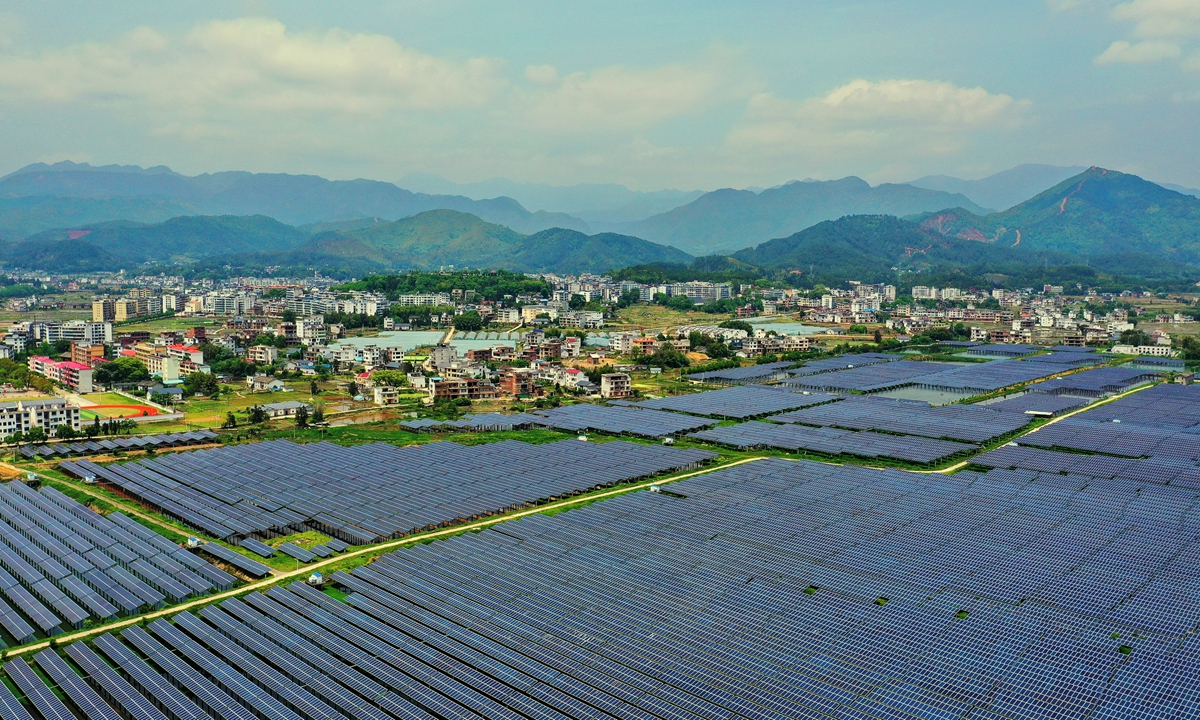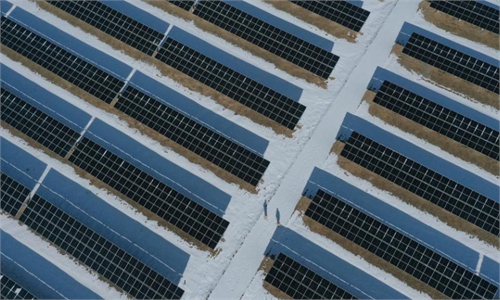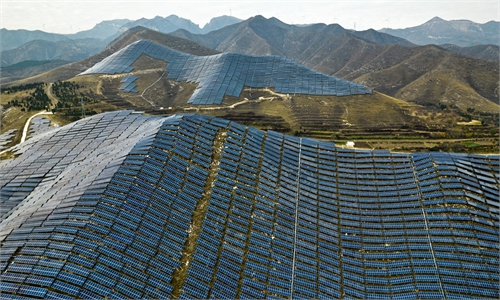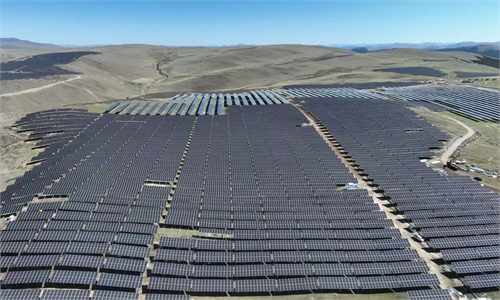China maintains leading role in global PV market, but tech investment & global layout necessary to keep competitive edge

An aerial view of a 30-trillion watt photovoltaic power generation project in Ganzhou, East China's Jiangxi Province, on May 5, 2022. Photo: VCG
The competition landscape in the global photovoltaic (PV) sector has gotten increasingly fiercer amid growing geopolitical uncertainty and intensifying China-US competition, with the brief arrest of a Chinese PV company executive in Germany once again putting China's booming PV industry under the global spotlight.
Ranked as a global leader with the most complete supply chains, China's PV industry still faces mounting challenges such as a US-led Western crackdown and a serious involution, industry insiders and experts said. They noted that Chinese PV companies should step up technological and innovation investment, promote coordination and cooperation for orderly competition, and diversify overseas layout to deal with challenges and risks.
"PV is one of the few strategic emerging industries in China that could participate in international competitions," a manager in the international business department of domestic photovoltaic (PV) producer Yingli Group, who preferred to remain anonymous, told the Global Times on Tuesday.
China has overwhelming advantages in some industrial and supply chains, with major production links such as solar cells and silicon ingots accounting for over 80 percent of the global total. Meanwhile, the country's solar-cell in-lab efficiency has broken world records 42 times since 2014, the above-quoted manager said, noting that China's PV industry is developing an integrated model to assess solar energy potential, as power storage for household use also witnesses rapid development.
Global champion
Having started from scratch, China has become the world's largest PV manufacturer and consumer after more than a remarkable 20-year period of development, with the center of the global new-energy industry further shifting to China.
"Over one decade ago, China imported raw materials and equipment for manufacturing PV products and then sold them overseas," Lin Boqiang, director of the China Center for Energy Economics Research at Xiamen University, told the Global Times on Tuesday. "However, the country has achieved self-reliance from PV equipment to supply chains, coupled with a complete industrial layout as well as a leading global position in comprehensive technologies."
The advantage of China's entire industrial chain, strong production, and supporting capabilities has made Chinese PV products highly competitive in the international market, Lin said, noting that the overall cost and performance of Chinese PV products are superior to those made in the US and the EU.
According to data released by the China Photovoltaic Industry Association (CPIA) on Monday, China's export volume of PV modules reached $42.36 billion in 2022, up 72.1 percent year-on-year.
Eight of the world's top 10 solar cells manufacturers come from China, with one from the US and the other from South Korea, according to the association.
Driven by strong business acumen and competitive decisions, Chinese PV manufacturers have conducted rounds of production expansion and stepped up investment in new technologies over the last two decades, leading to a significant price drop in PV power generation globally.
Data from the International Energy Agency (IEA) showed that China is the most cost-competitive manufacturing location for all components in the solar PV supply chain. Costs in China are 10 percent lower than in India, 20 percent lower than in the US, and 35 percent lower than in Europe, according to data from the IEA.
Challenges persist
Cutthroat competition, however, is unfolding in China's PV sector amid rapid production expansion and increasing trade barriers from countries including the US, India, and Canada, according to industry insiders and experts.
Although market demand still maintains high-speed growth, production capacities of major domestic PV companies have expanded faster than demand, leading to oversupply, Wei Fulei, deputy director of the Department of New Energy and Low Carbon Development at the China Development Institute in Shenzhen, South China's Guangdong Province, told the Global Times on Tuesday.
From the beginning of 2022 to the end of April this year, there were at least 460 production expansion projects in the PV industry chain, Wei said, citing industry data.
In order to control costs, improve efficiency, and ensure market share, leading domestic PV companies have stepped up their layout in relevant upstream and downstream industries, resulting in competition rather than cooperation among companies along the supply chain, he said. This further leads to involution and lower profit margins, he noted.
Additionally, disruptions of the global supply chain and international energy shortages since the Russia-Ukraine conflict began have pushed the US and the EU to support their local PV production, which poses greater challenges to China's PV exports, experts said.
On June 13, media reported that a Chinese PV company executive was briefly taken away by German police to assist in an investigation, arousing concerns that China's PV industry might be the next battlefeild of US containment of China's technological rise.
However, business insiders said that the matter in which the executive is involved is an old case and will not impact China's entire PV industry in any way. "Currently, there are only a few countries that have imposed unfair trade barriers on Chinese solar firms, though the possibility cannot be ruled out that more countries will follow suit," the manager at the Yingli Group warned.
With the excuse of the "forced labor" accusations against businesses in Northwest China's Xinjiang Uygur Autonomous Region, the US banned in 2021 imports of a key solar panel material from a Chinese company named Hoshine Silicon Industry Co. The US continually mulls over new duties to levy on imports from some major Chinese solar panel makers, according to media reports.
Meanwhile, the US is now using a fiscal stimulus package in which its Inflation Reduction Act is expected to boost the domestic production of clean energy through products such as solar modules. The EU is reportedly launching an industrial alliance for solar energy so as to make the PV production back to the continent.
Strive for breakthroughs
In order to effectively promote the sound development of China's PV sector and deal with a US-led Western crackdown, Chinese PV companies should maintain a competitive edge with investment in technological innovations and promote integrated development within the industry chain for orderly competition, Wei said.
"More importantly, we should set up and further improve PV industry standards, which will help China gain a competitive advantage in the international market and ensure the country's driving seat and pricing power in the global PV industry," he said.
Amid fiercer domestic and global competition, Chinese PV companies are energized to come up with new technologies to shore up global dominance in the sector. Domestic solar energy company LONGi Green Energy Technology Co, for example, told the Global Times that it has recently achieved conversion efficiency of 33.5 percent for silicon-perovskite tandem solar cells, an increase of 1.7 percent from the previous 31.8 percent just achieved in May this year.
In addition, Chinese PV firms have ramped up efforts to diversify in markets such as Southeast Asia, the Middle East, and North Africa to avoid potential geopolitical risks which have increased in recent years.
Domestic PV firm TCL Zhonghuan Renewable Energy Technology Co announced on May 24 that it has signed a cooperation agreement with Saudi Arabian new energy firm Vision Industries Company. The two sides will establish a joint venture to carry out new projects in PV products and materials in Saudi Arabia, as a bid to promote the energy transformation of the country, as well as the greater Middle Eastern region.
"Global layout of production capacity is a future trend, as it will not only help increase a company's market share through local policy support but also guard against trade barrier risks," the anonymous manager with Yingli Group said.



